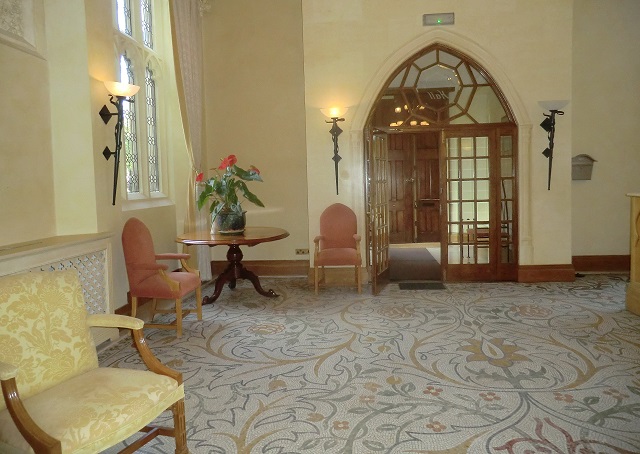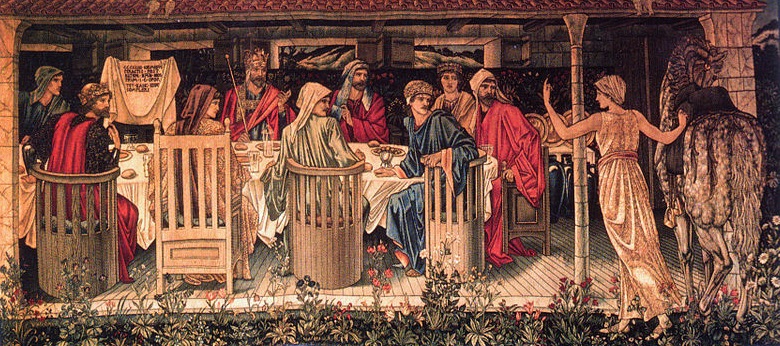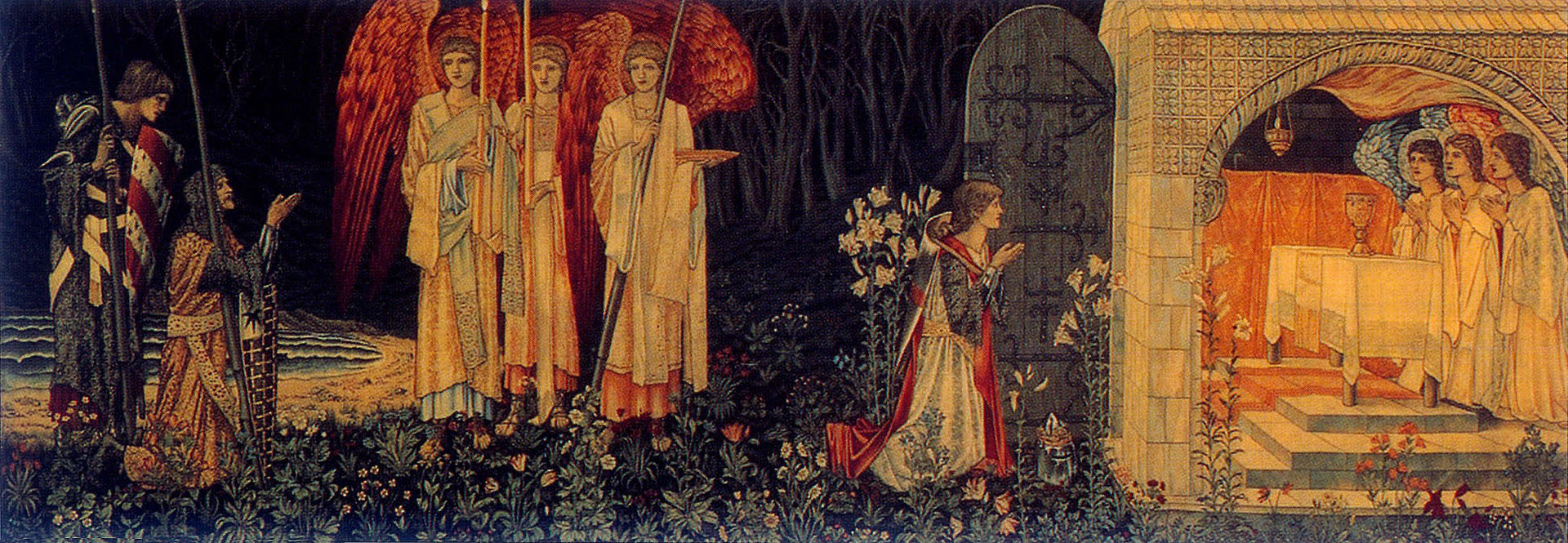Since time immemorial great houses, palaces and castles have been furnished with grand tapestries, so when the 'king of gold', William Knox D'Arcy purchased Stanmore Hall, he wanted to have his palace decorated to the same degree. Before D'Arcy moved into Stanmore Hall, it was a modest size estate house, but employing the eminent British architect Brightwen Binyon, William had the hall enlarged and redeveloped into the Gothic style castle that we know today .
Now, D'Arcy wanted to interior to match the palatial elegance of the exterior so engaged the services of William Morris and co. William Morris was the leading arts and crafts interior designer of the day, but this commission was to become his biggest and most famous project in the company's history. William Morris produced and supplied mosaic flooring, wallpaper, furniture, decorative ceilings, carpets and rugs. But the most famous accomplishment was to be his pièce de resistance, the Holy Grail tapestries.
The History of Tapestries.
The history of tapestries can be traced back to the ancient empires of Egypt, Greece and Persia, it is one of the ancient arts of weaving fabrics where coloured weft threads are woven between fixed warp threads to create patters or designs.
The earliest written word on the subject was in the biblical text of Exodus chapter 26, and Egyptian paintings dated from 3000 BC show women weavers at work on looms.
The Incas buried their dead in tapestry woven cloth, the trade spread throughout the Greek Empire and the Parthenon, had its walls decorated by them. It was however the French medieval weavers who would dominate its production until the hundred years war in 1337 when the weavers fled to Belgium taking their trade with them.
Popular woven scenes included landowners hunting, commonfolk toiling, ancient myths and folk law, unicorns were also a common feature. The church would use textiles to illustrate Biblical stories and kings and emperors would commission them after great victories. Becoming the status symbol of the wealthy, tapestries would cover the walls of palaces, cathedrals and chambers, and the homes of the affluent.
Other than being pleasant to view there was a practical side of tapestries, in cold stone castles they help to bring insulation to a room, they could provide privacy in bedrooms, as bed and furniture covers and help cover drab areas or to make rooms smaller and easier to heat. Unlike painted works of art, they could simply be rolled up and transported as nobles or kings moved from castle to castle. They could be taken to war and also become spoils of war often changing owners after battle.
From the middle ages weavers worked from sketches sometimes using artistic licence, by the renaissance they had become full size drawings called cartoons and they were copied exactly as the artist had drawn them.
In 1663 Les Gobelins factory was opened in Paris, it employed over 800 artisans producing tapestries for the Royal court. Two years later the tapestry workshop at Aubusson was granted a royal charter to produce coarser and, therefore, cheaper commercial wall-hangings, these pieces could be picked up by the new rising middle classes. This all went well until the French revolution, when tapestry production went into decline as they were viewed as objects of the Bourgeoise.
It wasn't until the invention of the Jacquard mechanical loom in Flanders in 1804. That production really took off again, this new loom used perforated cards, a bit like our early computers, which fed the coloured yarns to the shuttle. It enabled tapestries to become accessible to a wider market and to some extent is similar to what is used today.

William Morris
Fads come and go and the world of tapestries was on the decline again especially in the UK where paintings were seen as the Objet d'art to own and show, but one man in England that was beginning to take an interest in the world of tapestries was one William Morris.
Morris admired the world of arts and crafts, and it was said that he designed and made his first rolls of wallpaper, because he couldn't buy any that he considered nice enough. After leaving school he attended Exeter College in Oxford, it was here that he met the painter Edward Burne-Jones and was the start of a friendship and business partnership that was to last a lifetime.
They started a company in 1875 called Morris and Co. they produced wallpapers and carpets spearheading the new arts and craft movement in Britain. In 1878, eager to expand his company's product line he headed off to Aubusson in France to visit the French weavers. Unimpressed by their set up which he called “a decaying commercial industry of rubbish” but Impressed by their trade, he had a high-warp loom build in his bedroom and set about teaching himself how to weave from an old 18th century manual. Getting quite proficient in his new trade. By 1881 he purchased some larger Jacquard looms, increased his workforce and moved to premises in Merton Abbey, Surrey, with these new machines he could cope with making larger rugs and then progressed to carpets.
They would produce everything themselves for the projects they were working on, at the time their competitors were using new-fangled artificial colours derived from coal tar, Morris despised this technique calling it 'one of the most useless inventions of modern chemistry'. Most of the dyes used in their production were made themselves Morris said that the water from the Wandle was just perfect for making Dye, but it was Morris incredible ability to take traditional designs and then reinvent them adding his own personal flair that helped his company stand out from those around them. He amassed a few likeminded artisans and they designed and produce a few tapestries of their own Morris and Co. tapestry production was open for business. The company also employed the renowned painter Edward Burne-Jones, and the two of them worked in collaboration on many famous pieces.

One of Morris most famous early pieces was the Woodpecker created in 1885, taken from the Latin poet Ovid's Metamorphoses, it refers to the legend of Picus, one of the ancient kings of Italy, who refused to be seduced by Circe and in revenge was turned into a woodpecker. In the tapestry the woodpecker sits in a tree surrounded by flowers and falling leaves. Standing three meters high this magnificent piece was the all devised and directed by Morris’s artistic mind and know how. His thirst for artistic knowledge and learning often saw Morris creating his own dyes to colour the threads that went into his woven works of art he could take medieval designs and illustrations and add his own more decorative touch with woodlands and nature swirling around the central scene.
The Stanmore Hall Commission.
When William Knox D'Arcy moved back to England in 1889, he and his family moved to Stanmore Hall, He employed the services of Brightwen Binyon the architect and had the Hall greatly enlarged, the interior decorated like a palace, and the gardens landscaped.
He commissioned Morris & Company to decorate the interior, it was to be Morris largest commission to date and as time has shown one of his most important, it encompassed not only textiles, wallpapers, carpets, furniture and mosaic flooring but also a suit of the now famous Holy Grail Tapestries.

The Holy Grail Tapestries.
The holy grail tapestries are a suite of tapestries depicting the 15th century legend of King Arthur with the knights of the round table in their quest for the Holy Grail, the cup from which Jesus and the disciples drank at the Last Supper as told in Sir Thomas Malory's Morte d'Arthur 'The Death of Arthur'. The story tells how the knights travelled by ship for part of their journey to Sarras, where the Holy Grail was to be discovered.
After a discussion between D'Arcy and Morris about the designs for the tapestries, Morris wrote,
" I have had a careful discussion with Mr Burne-Jones on the tapestries for the dining-room at Stanmore and after considering the spaces to be filled, the light in the room and other circumstances, we have come to the following conclusion. The subject chosen for the illustration is the Quest of the Sancgreal which forms the latter part of the world-wide romance of the Morte d'Arthur".
It was decided that the main wall would be best suitable for the attainment of Sir Galahad of the Sancgreal' he will be landing from his ship at the final resting place of the Sancgreal 'Sarras the Spiritual City'. Then will come the Sancgreal borne amidst a company of angels, and lastly, occupying the space over the door, the City of Sarras designed with all the necessary splendour. Here again there will be many figures, the space itself lending itself to a great display of the richness of tapestry design....
Six tapestries were made in total each depicting a different scene from the Arthurian legend. They were a Morris and co. group effort with Edward Burne-Jones working on the characters, William Morris on the Heraldry and John Henry Dearle covering the landscape.
Panel 1 - Knights of the Round Table

Summoned to the Quest by the Strange Damsel
The story starts in the first panel, the knights are seated around the table, Arthur is holding court and can be seen wearing a crown with a gold staff in hand, he is in council with Sir Lancelot, also wearing a crown, and seated on his left. When they are interrupted as the strange damsel arrives at court to summon the knights to the quest.
The other knights are Sir Bors, Sir Kay, Sir Lamorah, Sir Gawaine, Sir Palomedes, Sir Perceval, and Sir Hector de Marys. Sir Galahad, who is Sir Lancelot's son, and the only knight worthy of attaining the Holy Grail, is yet to arrive. He is represented by the empty chair, draped with a cloth bearing a Latin inscription and known as the 'Siege Perilous'.
The Arming and Departure of the Knights

In this second panel the knights are on horseback and preparing to depart for the quest. The virgin ladies from Arthurs court assist them with their weaponry. Sir Gawaine, who will fail in the quest, appears mounted on the right of the picture, identified by his shield, which bears a double-headed eagle.
On the far left, Queen Guinevere hands Sir Lancelot his shield, in an allusion to their adulterous relationship, another knight who will fail the quest. This tapestry is owned by Led Zeppelin guitarist and founder Jimmy Page which he purchased from an auction at Sotheby's.
The Failure of Sir Lancelot to Enter the Chapel of the Holy Grail

In this scene we see Lancelot lying asleep with his back propped up against a well. His house is nearby and his shield hangs from a nearby tree. Bright light can be seen shining from the chinks in the door suggesting the presence of the Holy Grail but his path is blocked, as it guarded by an angel warder of the Temple of the Holy Graal.
Lancelot is another knight unworthy of the Grail, for according to Christian tradition he has allowed human perfection in the form of Guenevere to supplant the image of God.
In this panel two of Arthur's knights Sir Uwaine (left) and Sir Gawaine (right) stop to pray at a deserted chapel, after many days of riding. They see brilliant light emanating from within the chapel, suggesting the presence of the Holy Grail
Unfortunately for the two riders, they are both denied entry to the chapel. They find an angel blocking their path who tells them they would not be permitted to enter as they had previously led sinful lives lacking charity, virtue, and faith.
The Failure of Sir Gawaine

In this panel two of Arthur's knights Sir Uwaine (left) and Sir Gawaine (right) stop to pray at a deserted chapel, after many days of riding. They see brilliant light emanating from within the chapel, suggesting the presence of the Holy Grail
Unfortunately for the two riders, they are both denied entry to the chapel. They find an angel blocking their path who tells them they would not be permitted to enter as they had previously led sinful lives lacking charity, virtue, and faith.
The Ship

The Ship, this is a stand-alone piece, linking the other panels together. Burne-Jones was said to have produced scale models of ships in the researching of this tapestry. It contains none of the central characters but just the vessel at dock. The knights travelled by boat enroute to the mystical island of Sarras where the vessel that Jesus was supposed to have drunk from was to be discovered. Ships were commonly used in medieval story telling transporting characters from one world to another.A further version of The Ship was woven for Mrs Middlemore, wife of the Birmingham leather manufacturer Thomas Middlemore, and bequeathed to the Birmingham Museum in 1947
The Attainment or The Achievement of the Grail

The sixth and final scene from the legend shows the three successful Knights reach their goal in locating the Holy Grail. Sir Galahad kneels nearest the Grail which is perched upon an altar inside the chapel, he is surrounded by white lilies symbolising his purity.
Sir Bors and Sir Perceval are a small distance away and are joined by three angels, one carrying the bleeding lance of Longinus, the Roman soldier who pierced the side of Jesus while he died on the cross. Above the Holy Grail is a Pentecostal wind, symbolising the presence of the Holy Spirit.
Verdure with Deer and Shields

A verdure as it's name implies is a type of tapestry that represents trees plants or wooded landscapes, sometimes with birds or wildlife. These sorts of tapestries were hung underneath or beside the main panels to add natation to the story or legend. The Stanmore tapestries had four such Verdures narrating the Grail legend around the walls of the dining room. Each had an inscription and were decorated with deer drinking from a stream in a wooded clearing.
Above their heads were knight's shields hanging from the trees and the text stating these are the arms of certain knights of the round table bidden to seek the sangreal who departed on the quest. This Verdure was adapted by J H Dearle in 1900, from Burne-Jones's design for the original one which hung below The Summons.
So, what happened to Morris, D'Arcy and the tapestries?
D'Arcy had an eventful life, at one point being able to lay claim to all the oil in Persia. His company the Anglo Persian Oil Company would later be renamed British Petroleum or BP that we know today. He died on 1 May 1917 and is buried in St. Johns church Stanmore. The tapestries remained at Stanmore Hall until after D'Arcy's death, and In 1920 along with many other features of the Hall, they were subsequently sold off and dispersed. They were sold at Sotheby's London, 16 July 1920, and advertised as `A Superb Set of Twelve Tapestries' they were purchased by the 2nd Duke of Westminster for Eaton Hall, Cheshire. Some have since found their way into private collections around the country.
Morris died in 1896, his production plant in Merton carried on now headed by two of his junior partners Frank and Robert Smith. His old partner and lifelong friend Burne-Jones died two years later; his role would now be filled by artistic director John Henry Dearle. Dearle started at the company as a young apprentice, he was trained by Morris and in time became a master weaver, and the company's chief designer They took on a new director in 1905 called Henry Marillier and the company changed its name to Morris & Co. Decorators Ltd.
A couple of other sets of Holy Grail tapestries were woven by Morris & Co. one for the drawing room at Compton Hall, Lawrence Hodson's seat near Wolverhampton. A third complete set was woven for George McCulloch in 1898 and 1899. Some hangings from these subsequent weavings are in the Birmingham Museum and Art Gallery. Others are in the collection of Andrew Lloyd Webber. The Stanmore Hall weaving of The Attainment was purchased by Led Zeppelin guitarist Jimmy Page. In 1925 the company was renamed as Morris & Co Art Workers Ltd, unfortunaly after Dearle's death in 1932 its Morris inspired artistic flair died too, new orders started to decline and the company went into liquidation in May 1940.
Morris's designs still hold so much sway that over 160 years after he first started producing them, copies of his work can still be purchased in many high street retailers for today's homes.
